Part I: Script
- About the script itself
—— The epidemic breaks out. At the dawn before the end of the world, should human beings obediently wait for everything to turn into stones and ashes; or should we be brave again? Either to save lives or to sacrifice for common interests; Or just to let ourselves have fewer regrets when we are powerless. The disaster came suddenly, and we have no experience, so we are all EXPLORERS, looking for better possibilities in the unknown and disaster…
Our whole project is based on the story The Plague by Yan Leisheng. The epidemic came and people who were infected would become unable to move in a quite short time. Although they still had consciousness, they would be sent to burnt once they were unable to move their bodies.
Scene 1: Jason, as a guard at the checkpoint during the pandemic to check if anyone gets infected, has a Virus Scanner 🔍 🦠, which can be used to check positive/ negative and show the gradient of infection. That’s the first scene of our performance: Citizens stayed in the queue and waited for checking.
Scene 2: Then came the next scene of the performance. Jason, the guard was afraid of getting infected by the virus due to his highly dangerous job. So, he went to visit his scientist friend Professor. Lau (Justin) to see if there was any new invention to protect himself from being infected. Then, Justin showed him his newly developed Air Field Helmet 👨🚀 to purify the air and isolate the virus.
Scene 3: With the protection of the helmet, Jason went back to work again and this time he detected someone being infected and this poor guy was exactly Isabella. She was taken away and got separated. Then, Joyce, the doctor used the Vital Sensor 🩺 to test the vitals of Isabella. It showed that though the person had almost turned into stone, she still had life. The guard came and used his virus scanner again. It showed that the gradient of infection had reached 70%. Only her eyes were able to make some movements at that point. The doctor suggested that they should minimize the patient’s pain before she totally succumbed to the virus and was sent to burn.
Scene 4: To reduce the regret of the patient. They sent Isabella to the 🫧 One Last Dream House, where patients wore the Smart Eyewriter 👀 👓 to write with their eye movements to fulfill their one last dream, that was, to create a digital image of themselves and the place they wanted to go most before dying. They could live permanently as digital lives there. Following the instructions on the screen, Isabella started to write and choose by writing with her eyes. Step 1 was to scan her face. Step 2 was to write keywords to choose her suit in the digital world. [She wrote “butterfly”.] Step 3 was to write keywords to choose the scenario she wanted to go to. [She wrote “Rosey”.] After the scenario was formed, she was sent to burn.
Scene 5: Yes, the patient was sent to be burnt in the real world. While her digital image did gain a permanent life in the 🦋 Digital World 🌷. There, in her favorite butterfly suit, she could still see lovely roses in bloom.
My roles in the script: Scene 1: Citizen in queue; Scene 3: Citizen in queue/ One of the guards to take Isabella to be separated; Scene4: the voice of the Dream House; Scene5: One of the roses.
- How we come up with this idea and our modifications during the whole process
📅-02/20: We first met on 02/20 to share our ideas for the three stories. Some ideas were great yet were hard to make and perform. Most of my teammates thought that our ideas for the story The Plague were easier to put into practice. Thus, Jason suggested that we combine our ideas to create a whole storyline under the pandemic (How people’s lives were like under the pandemic.) They need to use a helmet to protect them. The government will assign guards to detect viruses. People who got infected will be separated and sent to burn. Before they are sent to be burnt, out of humanitarianism, they can fulfill their one last dream and live permanently in the digital world. We all agreed that it was a good idea since it made everyone feel useful in the group and began to do our parts according to the idea we came up with.
📅-02/23:We brought the artifact we made and discussed how our script should go. We had 2 versions of the script indeed. The first version is to let Isabella be the protagonist throughout. [She was afraid she would get an infection and went to buy a helmet. She stayed safe and sound for a while, but since she was curious about the device, she took it off to look at it, and she then felt a little unwell. Unfortunately, she went to the checkpoint and was found to be infected with the virus.] We all gravitated towards this script from the beginning because of its focused and smooth storyline. But Justin felt that this sacrificed the efficacy of the helmet he made, so he disagreed with the script and proposed the script we performed later. The script is also very good, but the first part will be a bit procrastinated. Although I personally think the first version can highlight the use of helmet indeed, in order to respect everyone’s opinion, especially the opinion of Justin, the creator of the helmet, we finally adopted the second script, which is the script we finally performed
💡-WeChat Group: During the whole process, we all kept in touch with each other in our WeChat group to discuss and modify the script. Some reasonable changes [like to use one artifact or not] were made during the process to achieve the best performance effect we want and I would later further illustrate it in Part II.
Part II: Artifact Making and Introduction (Successes/ Failures)
- 👨🚀 Air Field Helmet — Save lives — Made by Justin
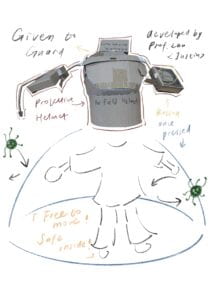
How it functions: Once the button is pressed, the airfield helmet will then pop up an invisible protective screen to isolate all viruses.
Successes: The helmet is well crafted. And we can see the interaction between the user and the helmet/ the interaction between the virus and the helmet.
Failures: The level of interaction is not that high. I don’t think it’s actually a failure. Because we all need kinds of stuff that may not be that interactive but are vital for life-saving during the pandemic.
- 🔍 🦠 Virus Scanner — Save more lives — Made by Jason
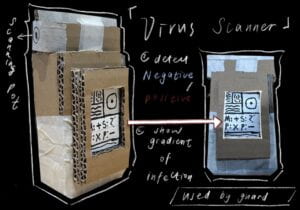
How it functions: Refer to the picture above.
Successes: It is light, portable and delicately crafted. The picture of the virus showing negative/ positive is especially clear and vivid (though I’m not sure if audiences can notice it or not since it’s quite small.) The cardboard is from the cardboard baskets that Jason used to carry his stuff when moving to the dorm. Green invention indeed!
Failures: Though I do think it’s a giant leap compared to the method of testing Nucleic acid right now, the degree of interaction is still not that high. The way that people and the artifact interact is not that interactive. Again, I don’t think it’s actually a failure. Because we all need kinds of stuff that may not be that interactive but are vital for life-saving during the pandemic.
- 🩺 Vitals Sensor — Sense lives — Made by Joyce
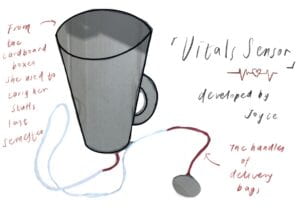
How it functions: It is quite similar to the heart monitor used in hospitals. One end with a sensor pressed to the patient’s chest. Wires transmit the heartbeat such that the doctor can listen to the heartbeat at the other end.
Successes: Green invention! Cardboard is cut out from the cardboard baskets that were used to carry belongings when moving dorm. Wires were made of the handles of delivery bags. Style and inspiration are similar to paper cup phones ( Many of us’s childhood memory indeed.)
Failures: Not that interactive and creative. But it is vital for our whole storyline.
- 🫧 Dream House/ Smart Eyewriter 👀 — Fulfill one last dream — Made by Luna
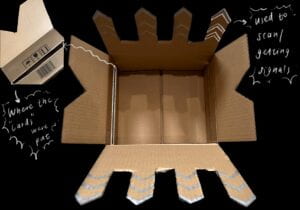
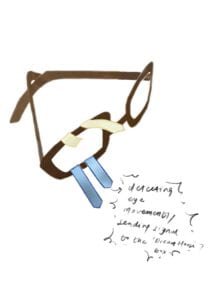
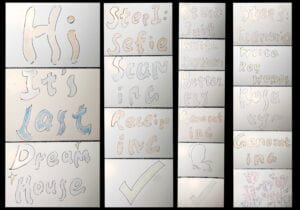
How they function:
Smart Eyewriter: Detect the movements of the eyes and send signals to the “House.”
Last dream House (A screen indeed): Give instructions to guide the user; Scan patients’ faces; Receive the signals from the Smart Eyewriter; Automatically form digital suits and scenarios according to the keywords. I use some white cardboard to mimic the whole process.
Successes: As Professor Gottfried said it was interesting, as both happy and sad stuff. We never know which will come first, tomorrow or the accident, so we always have too many regrets at the last moment. This device cannot solve all regrets. But at least it can reduce some regrets. It is like giving each individual the autonomy of deciding one’s fate even at the end of his life. It’s relatively interactive as a combination of sensors to catch slight movements and AR to help users get the scenes they want.
Failures: The dream house and the whiteboards are not big and clear enough.
- Digital World [Roses 🌷 and Butterfly 🦋] — Gain permanent life — Made by Luna
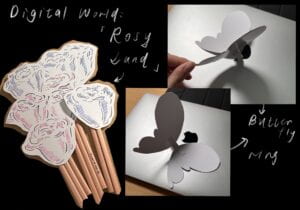
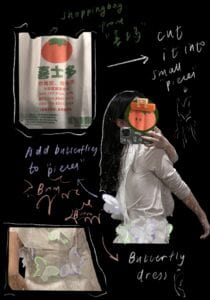
As for the last scene, we want to mimic a digital world where the users as digital lives, stay still there. So here I created some stuff like the Butterfly Ring, Roses and the Butterfly Dress according to the choices the user made in the dream house. We only used the butterfly ring and roses in our presentation after careful consideration. Initially, I was thinking about helping Isabella to put on this dress after Scene 4. Yet, it would take too much time. Since the dress doesn’t actually belong to the interactive technology, Isabella suggested that we just used the other two artifacts to mimic the scene. I do think it’s a good idea. So we adopted this plan at last. I think this suggestion is really useful and I might not be able to come up with this idea without her help.
Part III: Performance
- Successes: Our story was completed. And our acting skills were great I think LOLLL!
- Failures: We were a little bit out of time. Also, we should spend more time on the last part instead of focusing too much and spending too much time at the beginning part. Justin could have spoken louder on stage. Though I think his deep voice did fit his identity as a scientist in this performance. I should read the lines on white cards out loud such that the audience could know what is happening. (Sorry again to the audience on the left and right TT). Since we didn’t have much time by the end of the performance, we hurried to the stage at the last scene and we were not at the center of the stage.
[Oh, why did I list so many lines of failures while only one line of successes!? LOLLL. I’m not a cruel person. I think our performance is good overall. 👍]
- Video Here:
Part IV: Overall Reflection on our teamwork
I have to say our teamwork did have a long way to go if we want to get things better.
We need more cooperation and negotiation with each other instead of mainly focusing on our own ideas and artifacts. I think the overall effect is more important than showing how good something is personally made.
We, as a team, should find the focus of the whole story and lay out the workload more smartly.
I was a little bit surprised when Jason said the main focus of our project was the helmet. I definitely think the helmet created by Justin is a vital part of our story, while during our rehearsal, we all decided to give the last parts more time than the other parts. During the performance, we didn’t have so much time for the last parts indeed. Also, I think we would have achieved a better effect if we were able to make the dream house a bigger one with joint efforts.
We should also spend more time rehearsing, to negotiate and modify. I will ask for help in time to help the project achieve a better effect with joint efforts next time! That being said, I still want to say thank you and congratulations to myself and my lovely partners!
Part V: Peer Feedback on another group: Mirror 🪞
- Excellent Achievements 👏:
1 Their Artifact Mirror is very large and conspicuous, and people can immediately know what it is. It is also easy for the audience to notice when performing on stage.
2 Their script is wonderful. I think their ideas are great. This not only combines the story of Snow White but also links to the poor child. Use a mirror to reflect the two sides of the world, happiness and sorrow, self and others. It’s deep and meaningful.
3 The acting skills are very good. It can be seen that the team work has rehearsed many times, and the two girls were acting especially well when they put on lipstick. I especially like that scene!
4 Duck is very cute! Weirdo is lovely!
5 I like the details of the mirror very much. They have little scribbles on them that give this mirror a mysterious feel.
- Some Deficiencies 🔖:
1 The appearance of the two boys was slightly redundant. The plot was a little bit repeated.
2 The degree of Interaction was not so high, or in terms of interaction, this device is not so novel and smart. It is more like a transporter.
- My suggestions and proposal:
Generate users’ own image. Let the children in the basement be themselves. Let them sense the pain more intuitively. Or, since people’s happiness is exchanged for children’s pain, the mirror can let people see what kind of pain of the poor child is exactly exchanged for the pleasure of the people in front of the mirror. For example, it may be a car accident in which that person survived. He was not injured, but the child in the mirror took some kind of pain for him, such as a certain scar, etc. And then it transformed these pains into some physical effects, such as simulating cold, burning sensation to act on the person in front of the mirror.
- What can I learn from them:
Cooperation! Cooperation! Cooperation! Rehearsal! Rehearsal! Rehearsal! Let artifact be big! Big! Big!
Leave a Reply